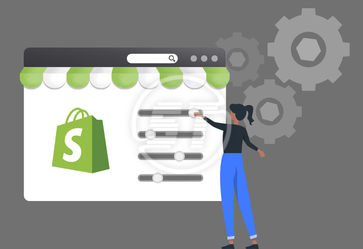A rapid shift has been witnessed in eCommerce platform dominance, with many businesses showing a keen interest in migrating to Shopify. They are willing to move from their clunky and outdated eCommerce platforms onto Shopify. However, one major challenge that every online merchant face during the re-platforming is the potential loss of SEO equity and a significant drop in organic traffic.
Every store owner wants to minimize the impact on their search engine rankings as it can result in some dire consequences and may even cripple the business. Businesses who were once garnering decent earnings also lost the bulk of their targeted organic traffic and went bankrupt due to botched migration. This would be a nightmare for any business that has spent long enough to build a reputation. But the good news is that with a solid re-platforming strategy, you can preserve your search engine rankings, boost organic traffic, and drive sales.
Without further ado, let’s dive in to see what you can do to retain your current SEO before you migrate to a sturdy eCommerce platform like Shopify.
Why is your SEO in danger when your online store is about to Migrate?
Search engines like Google, Bing use complex algorithms to rank your website pages. They regularly crawl through your website, index the pages, record the metrics like page loading speed, traffic, bounce rate, and these metrics would be factored into the rankings. Any changes to the on-page content and the new URL redirects if not informed properly to the search engines, you may end up losing your traffic. So, you need to lay down strong foundations before knocking down your old platform and move to Shopify.
To-do list before Migrating to Shopify
Benchmarking of pre-migration metrics
Track your website well in advance using some analytics tools and create reports on keyword rankings, organic search traffic, bounce rate, page load speed, conversion rate, mobile responsiveness, and other metrics. These help you in analyzing the performance of your current store and can also serve as a baseline comparison once your store do re-platform to Shopify. These benchmarks also help you have a keen understanding of what pages need to be preserved when migrating to the new platform.
Pre-migration Audit of the site
Perform a pre-migration audit of the current site to find out any discrepancies and issues that may cause problems. Detailed documentation of all the issues and the resolutions for the same should be outlined. Include all the items that do not follow best practices or that do not align with the Shopify website architecture.
The audit checklist includes -
- URL structure
- XML sitemap evaluation
- Internal link hierarchy
- Canonicalization
- 301 redirects
- 404 errors
- Internal server errors
- Markup data
- Technical optimization of content
- Mobile-responsiveness
Planning the Migration to Shopify
Many websites crash during the re-platforming or migration process and hence both the developers and SEO experts should work in tandem to ensure a proper migration plan. SEO shouldn’t be an after-thought. It has to be planned even before the migration starts. You need to have a detailed SEO roadmap with full documentation to ensure a smooth eCommerce site migration.
Re-platforming SEO checklist
Although there is no one-size-fits-all approach to strategizing SEO re-platforming, certain things remain constant for the majority.
1. Create the list of URLs
Prepare a record of all the URLs on the old site so that you can avoid missing out on any pages during the migration process. Also, create the redirects list and broken links on the new site. Make sure you do not include redirect chains i.e. redirects that lead to other redirects as it can increase page load times that impact your search engine ranking. You can use some tools like screaming frog to crawl through your site and create the list of all URLs, redirects, and broken links.
2. 301 Redirects
301 redirects indicate moving of the website pages to a new location. So the old URLs need to be redirected to the new ones so that the customers do not face any issues. You need to create a 301 URL redirect for every page. Shopify allows you to import these URL redirects as a CSV file.
3. Check internal links
When re-platforming, the content links need to be changed to a new URL, and the entire URL structure should be updated. You need to make sure that all the URLs are working and that there are no broken links.
4.Import metadata
Import the metadata - the titles, the meta descriptions, the h1 tags to the new platform as these are important elements that drive traffic to your store.
5. Content Changes
Keep the content changes to a minimal level. If you don’t have a blog yet, add rich content to your website that improves the search visibility.
6. SSL considerations
When you are migrating your eCommerce store, make sure you are updating to https. Consider all the internal linking and images which may also contain HTTP. Once they are converted, the old pages should be closed to avoid any duplication of the content. SEO equity would decrease if the pages are not secure and also in case of duplicated content.
7.Configure the analytics
Ensure that your analytics are set up perfectly and these help you to extract the metrics for the current site. By comparing these with the baseline metrics, you can calculate your return on investment (ROI).
8.Create a custom 404 page
While you are redirecting each page to a new URL, you may also have to wipe out the irrelevant pages. The pages that do not have an equivalent page on your new site or do not have a proper redirect page, goes to a 404 page. So, you need to craft an optimized 404 page. This prevents a dead end in the customer journey thereby, reducing the customer bounce rate as well.
9.Preserve the authoritative page SEO
Identify the authoritative and top-ranking pages of your ecommerce website using tools like Ahrefs. The URLs of these pages should remain the same even after migrating to Shopify which preserves the search engine rankings.
10.Post-launch Monitoring
After you are done with the migration, immediately crawl the site for any errors. Also, test for any issues that may have arisen during the migration. Monitor the traffic and search engine rankings to notice if there are any changes. If there are too many redirects, expect a significant shift from organic traffic to direct traffic.
Conclusion
Re-platforming can be a breeze if you follow the above checklist. As we mentioned earlier, SEO shouldn’t be an afterthought as it is extremely crucial to determine your visibility among your customers and can make or break your business. Skynet Technologies has a holistic and well-rounded tech and marketing team who can provide collaborative assistance to help you with seamless migration. Skynet Technologies can help you to make it to the other side with all of your SEO content intact.
We provide Shopify ecommerce services to fuel your business with enterprise level capabilities and keep your customer coming back! Whether you want to migrate to Shopify integrate any application, redesign your online store, Shopify store migration, require a new development and maintenance for your store, Let’s connect to build a new growth of your medium or enterprise business or retail store with Shopify development.


